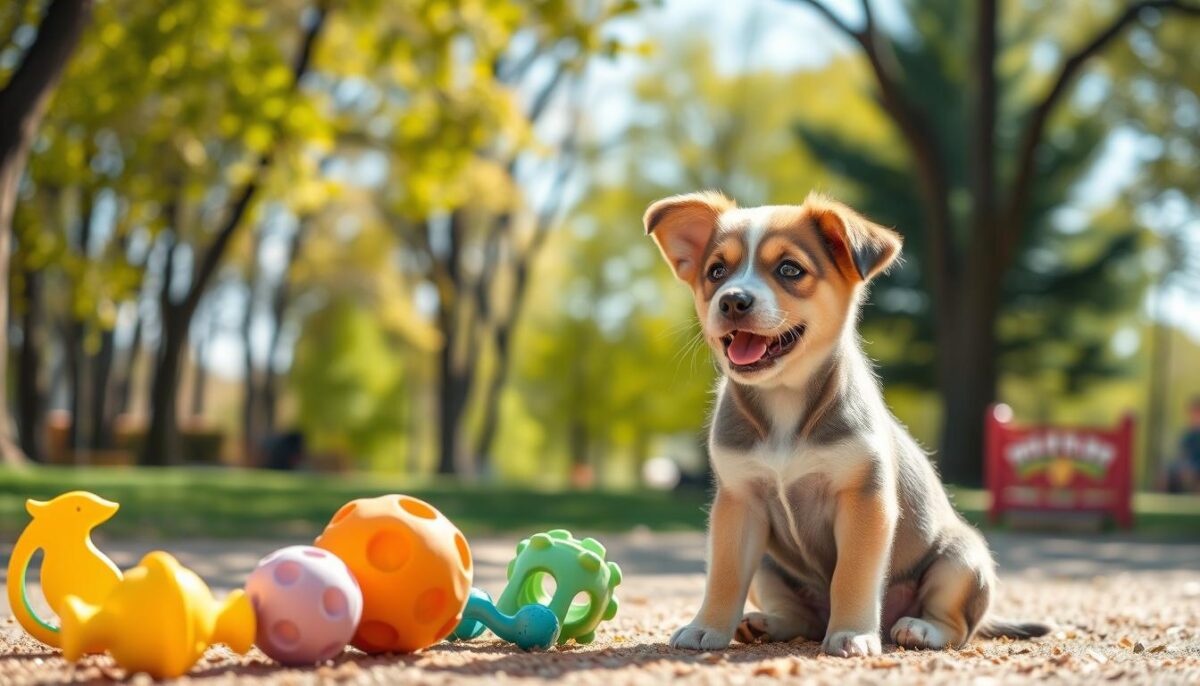Did you know that 90% of a puppy’s brain growth happens by 16 weeks? This shows how crucial early training is. As a dog trainer, I’ve seen how timing affects a puppy’s growth.
The best time to start training is between 7 to 8 weeks. Puppies soak up information like sponges at this age. Early training helps them grow into well-behaved dogs and strengthens your bond.
Creating a dog training plan is critical to success. Each training phase builds on the last. Learning to train a dog well takes patience, consistency, and understanding their growth stages.
Even though early training is best, it’s never too late to start. Older puppies and adult dogs can learn too. The trick is to adjust your training to fit your dog’s age and needs.
Key Takeaways
- Start puppy training at 7-8 weeks old for optimal results
- Focus on socialization and basic commands in the early stages
- Keep training sessions short, around 5 minutes each
- Use positive reinforcement techniques for effective learning
- Adapt your training approach as your puppy grows and develops
- Consistency is important throughout the training process
- Professional classes can supplement home training efforts
When to Start Training Your Puppy
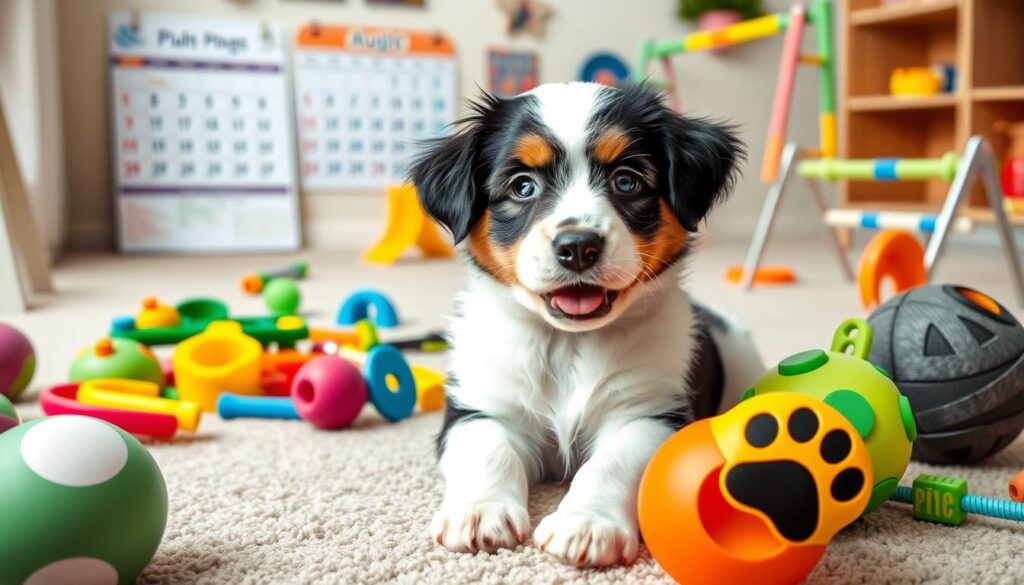
The best time to start training your puppy is at 7-8 weeks old. This age is perfect because puppies learn fast and absorb lots of information. It’s the ideal time to teach them basic commands and good habits.
The Ideal Starting Age: 7-8 Weeks Old
At 7-8 weeks, puppies can understand simple commands. Their brains are like sponges, ready to learn. Training them now helps them learn more in the future.
Training should be short, about five minutes, several times a day. This adds up to 15 minutes of training each day.
Why Early Training Is Crucial for Puppy Development
Training your puppy early has many benefits. It shapes their behavior during a critical time, until they are about 16 weeks old. Early training:
- Teaches good manners
- Helps prevent bad behavior
- Strengthens the bond between puppy and owner
- Makes them more responsive to commands
Being consistent is important in early training. Use the same words or hand signals for commands like sit, stay, or come. This helps puppies learn and remember commands better. Starting early means your puppy will grow into a well-behaved adult dog, making life easier for you.
Puppy Training Timeline

Understanding puppy development stages is vital to developing an effective puppy training schedule. Let’s look at the main milestones in a puppy’s early months.
7-8 Weeks Old
Puppies are ready for basic training at this age. Start with simple commands like “sit” and “come” during meals. Keep training short, about 5 minutes, to match their short attention span.
8-10 Weeks Old
This period is vital for socialization and potty training. Start potty training right away when they come home. Use their age in months, divided by two, to guess how long they can hold it.
Start name recognition exercises and keep it consistent.
10-12 Weeks Old
Expand obedience training with commands like “place,” “down,” and “heel.” Start leash and harness training for walks. Redirect chewing to the right toys. Training sessions can now last 10-15 minutes.
12-16 Weeks Old
Keep up socialization with calm dogs and new people after vaccinations. Move on to more complex tasks in obedience training. By 6 months, puppies should know basic commands like “stay” and “leave it.”
Establish a regular routine for outdoor trips to improve potty training.
Remember, a balanced diet supports growth during these stages. Stick to your puppy training schedule, and you’ll see great progress in your furry friend’s behavior and skills.
7-8 Weeks Old

Early puppy training starts at 7-8 weeks old. This is a crucial time for your puppy’s future behavior and social skills. Puppies are now ready to learn basic commands and start socializing.
I teach simple commands like “sit” and “come” using treats as rewards. I also help puppies learn their names. This makes them respond when called. To stop chewing on things they shouldn’t, I redirect their attention to toys.
Socialization is very important at this stage. I introduce puppies to family and close friends in a safe setting. This helps them feel more confident around people.
| Training Focus | Activities |
|---|---|
| Basic Commands | Sit, Come, Name Recognition |
| Socialization | Meeting Family, Friends |
| Behavior Management | Chewing Redirection, Potty Training Basics |
Having a daily routine is crucial. I set regular times for feeding, play, potty breaks, and naps. This makes puppies feel secure and helps them learn faster.
Training sessions should be short and fun at this age. Puppies can’t focus for long, so keep lessons to 5-10 minutes. Positive reinforcement is the best way to teach basic puppy commands.
8-10 Weeks Old

At 8-10 weeks old, puppies are in a critical time for learning to use the potty and crate training. They sleep a lot, up to 20 hours a day, to grow fast. Their bodies are still learning to control when to pee and poop, so they need to go out often.
It’s important to set a regular potty schedule for your puppy. Take them outside every 2-3 hours, after eating, sleeping, and playing. When they go potty outside, give them praise and treats to encourage good behavior.
Starting crate training early is also crucial. Make the crate a welcoming place with treats and toys. Start with short crate times and slowly increase it as your puppy gets used to it.
| Age | Potty Break Frequency | Crate Time (Max) |
|---|---|---|
| 8 weeks | Every 2 hours | 2 hours |
| 9 weeks | Every 2.5 hours | 2.5 hours |
| 10 weeks | Every 3 hours | 3 hours |
Keep up with basic obedience training with short, fun sessions. Use treats to teach good behaviors. Remember, being consistent is vital in teaching your puppy good habits during this important time.
10-12 Weeks Old

At 10-12 weeks, puppies are ready for obedience training. They are teething and need more social interaction. Teaching them basic commands is critical for their future.
Leash training is vital as puppies start moving around. Short, positive sessions help them get used to walking on a leash. Remember, they can’t focus for long.
Puppies need 18 hours of sleep each day. Their active times are great for training and play. I tailor training to fit their natural energy levels.
| Age | Sleep Needs | Training Focus | Feeding Schedule |
|---|---|---|---|
| 10-12 Weeks | 18 hours/day | Basic cues, leash training, socialization | 3-4 times/day |
Socialization is crucial at this age. I introduce them to new people and dogs after they’ve had their shots. This helps them feel confident and avoids fear later on. For more on dog obedience training, check out professional advice.
Positive reinforcement is my favorite way to train puppies. I use treats and praise for good behavior. It makes learning fun and strengthens the bond between puppy and owner.
12-16 Weeks Old

At 12-16 weeks, puppies go through an important time for learning and socializing. They start teething and can learn more quickly. This is a big part of their growth.
It’s very important to keep up with socialization during this time. Exposing your puppy to new things, people, and places helps them feel confident. Playdates with other vaccinated dogs can help them learn social skills.
Training at this age focuses on improving basic commands and adding new ones. Short, fun training sessions keep them focused. Here’s a sample training schedule:
| Time | Activity | Duration |
|---|---|---|
| 7:00 AM | Potty Break & Breakfast | 15 minutes |
| 8:00 AM | Basic Obedience Training | 10 minutes |
| 10:00 AM | Socialization Walk | 20 minutes |
| 2:00 PM | Problem-Solving Exercises | 15 minutes |
| 5:00 PM | Advanced Command Practice | 10 minutes |
Teething starts around 12 weeks. Give them chew toys to stop chewing on things they shouldn’t. Being consistent and using positive methods are important for good behavior.
By 16 weeks, puppies are ready for walks on a leash and meeting new people. This is a great time to start puppy kindergarten. It helps with training and social skills in a safe place.
4-6 Months Old
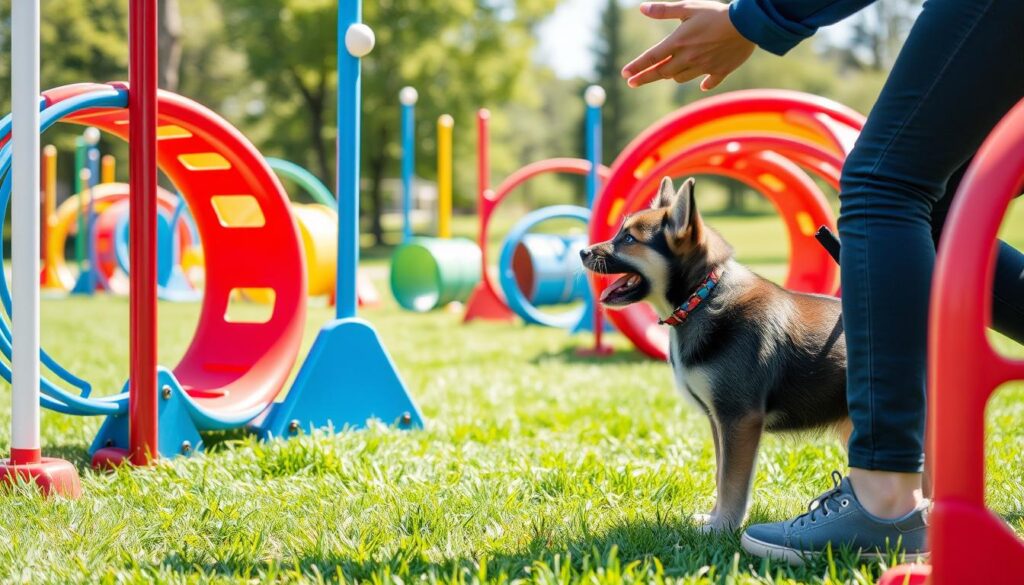
Puppies aged 4-6 months are in a vital development stage. They move from puppyhood to adolescence. This time brings new challenges and chances for dog training.
At this age, puppies start to show independence. This can lead to stubborn behaviors.
House training is still crucial. Take your puppy out four to six times a day. As they grow, you can reduce this number. A consistent routine helps them learn good habits. Remember, accidents can still happen, so be patient.
Health issues become more important now. Male puppies can produce sperm by 5 months. Female puppies can have their first litter by 6 months. Talk to your vet about spaying or neutering to prevent unwanted litters and health risks.
Dental care is also key. Most dogs have all their teeth by 6 months. Look out for teeth that don’t fall out and start brushing their teeth with dog toothpaste. Regular dental visits can prevent future problems.
| Training Focus | Health Considerations | Behavioral Changes |
|---|---|---|
| Reinforcing basic obedience | Spaying/neutering | Increased independence |
| Off-leash training | Dental care | Potential stubbornness |
| Controlled behavior in public | Vaccinations (e.g., rabies) | Chewing exploration |
Key Training Areas by Age
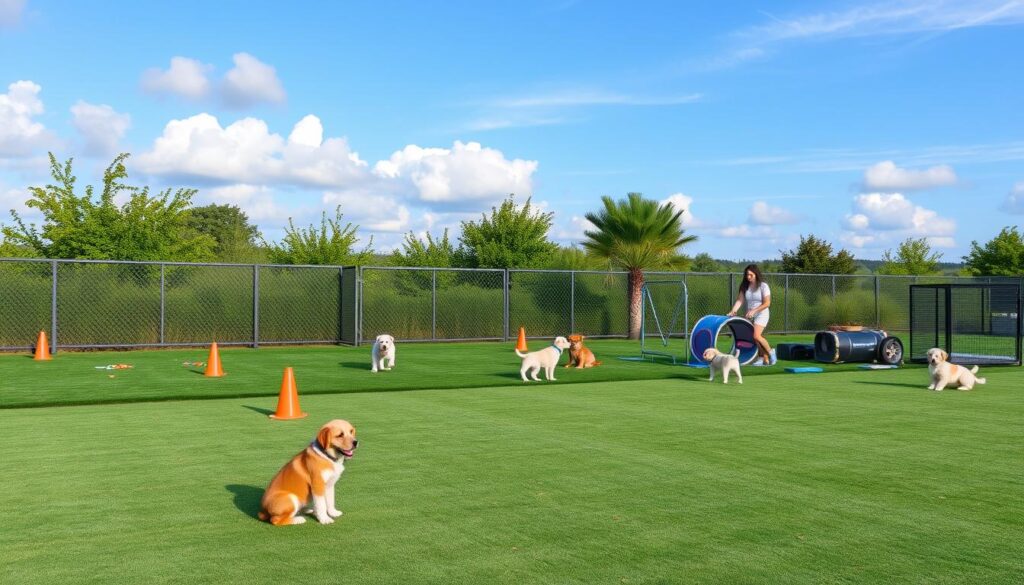
Training your puppy involves focusing on certain areas at different ages. Starting training early, around 7 weeks, helps your puppy behave well.
Socialization
The best time for socialization is between 8-16 weeks. Introduce your puppy to many people, animals, and places. This builds confidence and reduces fear later on.
Obedience
Begin with simple commands like “sit” and “stay” at 8 weeks. As your puppy grows, add more complex commands. By 10 weeks, they start to understand human gestures, making training easier.
House Training
By 2-3 months, puppies usually have reliable bladder control. Smaller breeds might need more time. Crate training helps with housebreaking and keeps them safe. Limit their freedom indoors to avoid accidents.
Behavioral Training
Deal with issues like nipping and jumping early. Teach them to be calm and gentle from the start. Being a leader from the beginning prevents future problems.
Every puppy grows at their own pace. A study of 101 Labrador and Labrador-Golden mixes showed cognitive skills develop on a general timeline. Knowing these stages helps you tailor your training for the best results.
Socialization: Critical period and ongoing importance

Puppy socialization is important to a dog’s behavior for life. The critical period is from 6 to 16 weeks, with some saying it ends at 12 weeks. During this time, puppies are most open to new things.
Behaviorists John Paul Scott and John Fuller found that 65% of a dog’s behavior comes from socialization and more. This shows how important early exposure is.
The American Veterinary Society of Animal Behavior suggests starting puppy classes at 7-8 weeks. It’s crucial to introduce puppies to new things before they’re fully vaccinated, usually by 4-5 months.
| Age (weeks) | Socialization Stage | Key Focus |
|---|---|---|
| 5-7 | Curiosity Period | Fearless exploration |
| 7-9 | Behavioral Refinement | Structured individual training |
| 8-11 | Fear Imprint Period | Cautious introduction to new stimuli |
| 9-12 | Environmental Awareness | Appropriate behaviors and motor skills |
| 13-16 | Seniority Classification | Dominance testing and critical learning |
It’s a good idea to expose your puppy to 100 people, 100 dogs, and 100 experiences by four months. This helps prevent fear and makes them adaptable to things like bicycles and umbrellas.
Obedience: Building a strong foundation

Puppy obedience training is vital to a well-behaved dog. I start teaching basic dog commands when puppies are 8 weeks old. This early start builds a strong bond and sets clear expectations.
For effective puppy obedience training, I keep sessions short and fun. Young pups can’t focus for long, so I aim for 5-15 minute sessions daily. Consistency helps puppies learn commands quickly.
I use positive reinforcement, rewarding correct behaviors with treats and praise. As puppies grow, I switch from food rewards to praise and affection. This method prevents aggressive behavior and builds a positive relationship.
To boost confidence, I practice commands in different places. This helps puppies adapt and respond well, even with distractions. By 6 months, most puppies reliably follow basic commands.
| Age | Training Focus | Session Duration |
|---|---|---|
| 8-10 weeks | Basic commands, socialization | 5 minutes |
| 10-12 weeks | Reinforcing basics, introducing new commands | 10 minutes |
| 3-6 months | Advanced commands, leash training | 15 minutes |
House training: Age-appropriate expectations
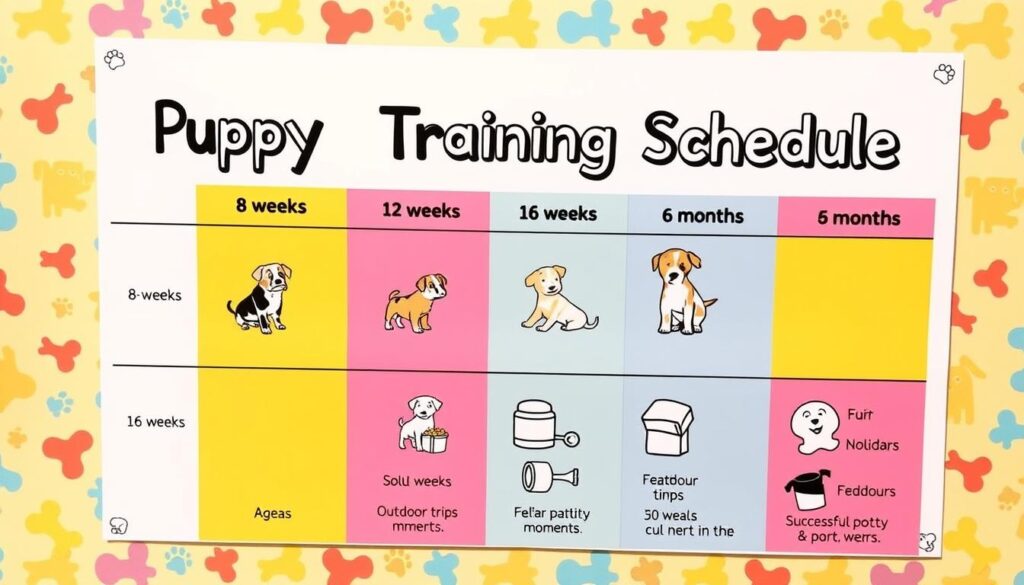
I start puppy potty training right away when a new furry friend comes home. The schedule for house training changes with the puppy’s age. Younger pups need to go out more often.
A good rule is the month-plus-one method. This means a two-month-old puppy can hold it for about three hours.
Being consistent is crucial for a good house training routine. I take young puppies out every one to two hours. This is especially true after meals, naps, and playtime. As they get older, I increase the time between potty breaks.
- 7-8 weeks: Hourly breaks
- 2-3 months: Every 2-3 hours
- 4-5 months: Every 3-4 hours
- 6 months and older: Every 4-6 hours
I expect big improvements in house training by 4-6 months with regular effort. Smaller breeds might need to go out more often than larger dogs. Remember, accidents are part of the learning process. Stay patient and keep a positive attitude.
Behavioral training: Addressing common puppy issues
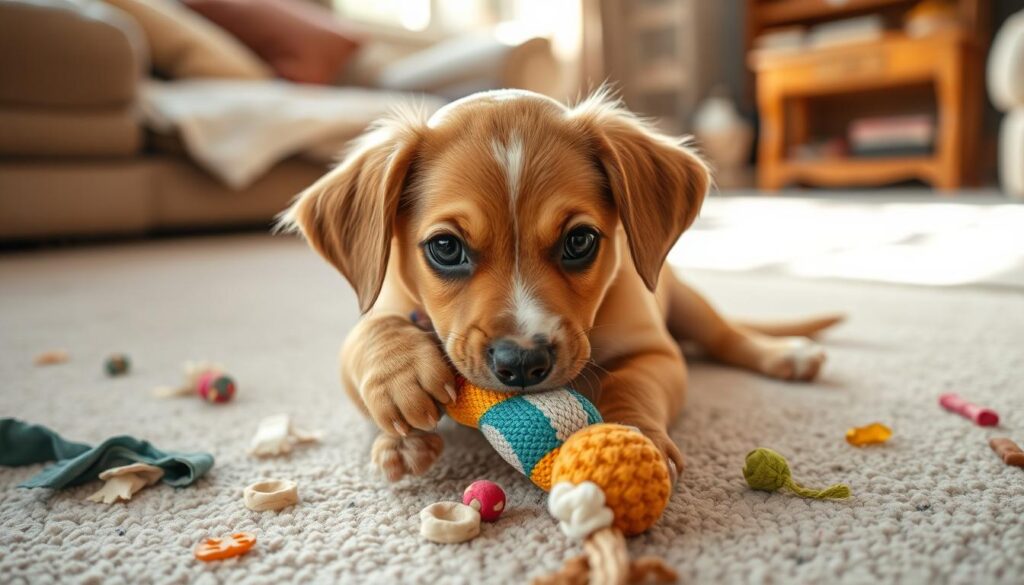
Behavioral training helps with puppy problems like nipping and chewing. These issues happen when puppies are teething, usually between 3-6 months. They chew everything because they’re learning about their world through their mouths.
To stop puppy nipping, teach them to control their bites. If they nip, say “ouch” and stop playing. This is how they learn from their siblings. Also, give them chew toys to chew on instead.
It’s important to be consistent with training. Set clear rules and reward good behavior. Train in short sessions. Teaching basic commands like “fetch” helps use their energy well.
| Age | Common Issues | Training Focus |
|---|---|---|
| 8-10 weeks | Nipping, chewing | Bite inhibition, redirection |
| 10-12 weeks | House soiling | Potty training, crate training |
| 3-6 months | Excessive energy | Basic commands, socialization |
| 6-12 months | Stubbornness | Advanced obedience, impulse control |
Puppies can’t focus for long. Keep training short, 5-10 minutes. End on a good note. With patience and consistency, your puppy will grow up well-behaved.
Training Techniques for Different Age Groups

Effective puppy training methods change with age. I’ll share techniques that work well for puppies at different stages.
Positive Reinforcement Methods
Positive reinforcement is important for all ages because it rewards good behavior, making puppies want to do it again without thinking too much about it. Treats, praise, and toys are great motivators.
Short, Engaging Sessions for Young Puppies
For puppies 8-12 weeks old, keep training short and fun. Try for 5-10 minute sessions, teaching basic commands like “sit” and “come.” Use treats and lots of excitement to keep them interested.
Gradually Increasing Training Duration and Complexity
As puppies grow, training sessions can get longer and more challenging. By 16 weeks, they can handle 15-20 minute sessions. Start teaching advanced commands and leash manners.
| Age | Session Length | Focus Areas |
|---|---|---|
| 8-12 weeks | 5-10 minutes | Basic commands, potty training |
| 12-16 weeks | 10-15 minutes | Leash training, socialization |
| 16+ weeks | 15-20 minutes | Advanced commands, behavior refinement |
Consistency is crucial in puppy training. Tailor your approach to your puppy’s needs and progress. With patience and positive reinforcement, you’ll raise a well-behaved dog.
Positive reinforcement methods

Positive reinforcement is important in reward-based dog training. It rewards good behavior to make it happen again. I use treats, toys, or praise to make dogs happy when they behave well.
Clicker training is a favorite for teaching new tricks. It uses a click sound followed by a treat. This helps dogs know exactly what they did right.
I use different rewards for different tasks. For easy things, praise is enough. But for harder tasks, treats or favorite toys are better. This keeps training fun and exciting for dogs.
Timing is everything in positive reinforcement. I give rewards right after the good behavior. This helps dogs connect the action with the reward. Everyone in the family should use the same rewards and timing to avoid confusion.
| Reward Type | Effectiveness | Best Used For |
|---|---|---|
| Treats | High | New commands, difficult tasks |
| Toys | Medium | Play-motivated dogs, recall training |
| Verbal Praise | Low to Medium | Reinforcing known behaviors, daily interactions |
| Clicker | High | Precise behavior marking, complex tricks |
Positive reinforcement helps avoid punishment, which can scare dogs. It makes training a positive experience. It also strengthens the bond between dogs and their owners.
Short, engaging sessions for young puppies

Young puppies can only focus for a short time. So, training sessions should be short and fun. I keep them to 5-10 minutes. This fits their attention span and keeps them excited to learn.
Mealtime is a great time to train. I use a little of their food as a reward. This makes learning fun and part of their daily routine.
To keep training fun, I add games and play. This makes them want to learn more. I always end on a positive note, so they look forward to the next session.
| Age Group | Session Length | Training Frequency |
|---|---|---|
| 8-10 weeks | 5 minutes | 5-6 times daily |
| 10-12 weeks | 7-8 minutes | 4-5 times daily |
| 12-16 weeks | 10 minutes | 3-4 times daily |
I teach basic commands like “sit,” “stay,” and “come” in these short sessions. These are the basics for more advanced training. By making sessions short and fun, puppies stay interested and eager to learn.
Gradually increasing training duration and complexity

As your puppy grows, I extend training sessions to 10-15 minutes. This helps meet advanced puppy training goals. I add more complex commands and tasks, building on what they’ve learned before.
I also practice in different places with more distractions. This helps them learn to focus better.
For progressive dog training, I adjust the difficulty based on the puppy’s progress and confidence. Daily mini-sessions greatly improve obedience and responsiveness. I use interactive toys and games to boost problem-solving skills, teaching patience and focus.
Different breeds have different needs for training. I tailor my approach for the best results. Puppies between 8-16 weeks can learn basic commands like “sit,” “stay,” and “come” in a few weeks with consistent practice.
For advanced skills, like dog protection training or agility, I wait until they’re about 6 months old.
Positive reinforcement is the fastest and most effective method. I keep sessions short and daily, leading to better results than sporadic, intense training. This method helps puppies learn quickly and eagerly, preparing them for advanced skills as they grow.
Common Challenges When Training Puppies at Different Ages

Training puppies at different ages comes with unique challenges. I’ll share these puppy training challenges and offer solutions. This will help you on your journey.
Short Attention Spans in Young Puppies
Puppies aged 8-10 weeks have short attention spans. Keep training sessions short, around 5 minutes, and fun. Use treats and toys to keep them focused.
Repeat sessions throughout the day for better retention.
Dealing with Teething and Chewing Phases
Between 3-6 months, puppies go through the teething phase. Give them chew toys to redirect their chewing. Freeze soft toys for soothing relief.
Supervise your puppy to prevent destructive chewing habits.
Managing Adolescent Stubbornness
From 6-18 months, puppies may show stubbornness. Keep training routines consistent and reinforce basic commands. Increase exercise to channel their energy positively.
| Age | Challenge | Solution |
|---|---|---|
| 8-10 weeks | Short attention span | Brief, engaging sessions |
| 3-6 months | Teething and chewing | Appropriate chew toys |
| 6-18 months | Adolescent stubbornness | Consistent training, patience |
Understanding these age-specific puppy training challenges helps set realistic expectations. Adjust your approach based on your puppy’s developmental stage for successful training outcomes.
The Role of Professional Training Classes
Professional training classes are critical for your puppy’s growth. I suggest starting them in classes around 8-10 weeks old, after they’ve had their first shots. This is when they learn best.
When to enroll in puppy classes
Puppy classes welcome dogs from eight weeks to five months old. Starting early helps your puppy learn important skills. These classes offer a great place for learning and making friends.
Benefits of structured training environments
Professional dog training offers many benefits. You get expert advice on how to train your puppy right. Your puppy meets other dogs and people, improving their social skills. They also learn new commands, preparing them for more training later.
Choosing the right class for your puppy’s age
Choose classes that fit your puppy’s age. Young puppies need short, fun sessions of 5-10 minutes. As they get older, classes can last 10-15 minutes. Remember, practice at home is important to their success.
